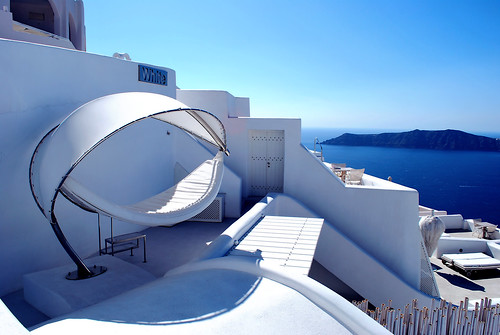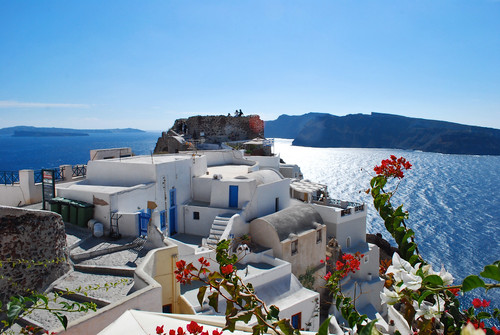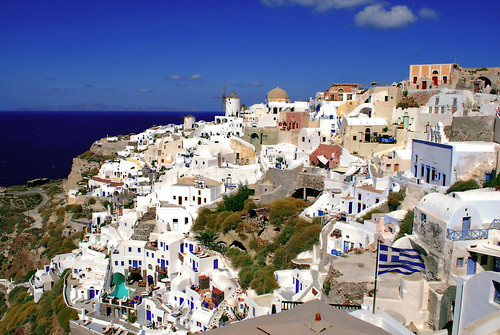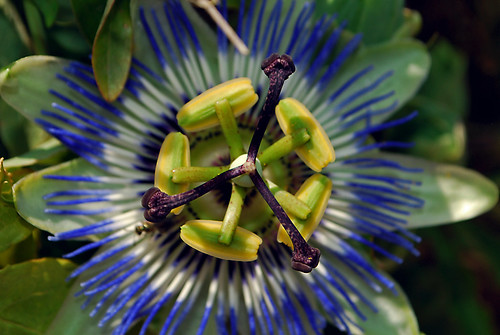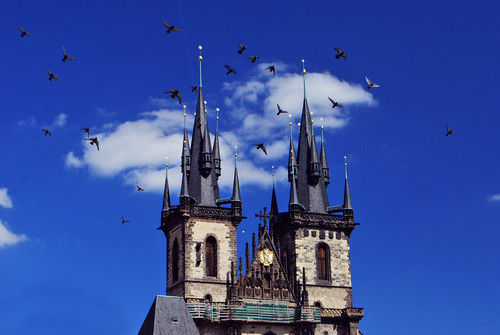Via Flickr:
Visit Our Website! II Facebook II Twitter II Tumblr
Due to the volcanic fertile soil, Santorini is famous for its unique products such as the white aubergine, the little cherry tomatoes, fava etc. You must taste tomato-balls (tomatokeftedes) made from the cherry tomatoes and mousaka with local aubergines and vegetables.greek salad Santorini has been famous for its wines from the ancient years. The fertile earth helps the cultivation and the development of vineyards. Many famous wineries can be found in Santorini such as Boutari, Cavana Roussos and Santo wines. Taste all 3 kinds - Brusko (Red / dry / strong), Nichteri (White / dry / strong), Vissando (Red / sweet / extremely strong; reminds the liqueur). As far as sweets are concerned, taste spoon-sweets which are made from whole cherry tomatoes seasoned with cinnamon and whole almonds.
About Santorini:
Santorini (Greek: Σαντορίνη, pronounced [sadoˈrini]), officially Thira (Greek: Θήρα [ˈθira]), is an island located in the southern Aegean Sea, about 200 km (120 mi) southeast from Greece's mainland. It is the largest island of a small, circular archipelago which bears the same name and is the remnant of a volcanic caldera. It forms the southernmost member of the Cyclades group of islands, with an area of approximately 73 km2 (28 sq mi) and a 2001 census population of 13,670. The municipality of Santorini comprises the inhabited islands of Santorini and Therasia and the uninhabited islands of Nea Kameni, Palaia Kameni, Aspronisi, and Christiana. The total land area is 90.623 km2 (34.990 sq mi). Santorini is part of the Thira regional unit.
Santorini is essentially what remains after an enormous volcanic explosion that destroyed the earliest settlements, on a formerly single island, and created the current geological caldera. A giant central, rectangular lagoon, which measures about 12 by 7 km (7.5 by 4.3 mi), is surrounded by 300 m (980 ft) high, steep cliffs on three sides. The main island slopes downward to the Aegean Sea. On the fourth side, the lagoon is separated from the sea by another much smaller island called Therasia; the lagoon is connected to the sea in two places, in the northwest and southwest. The water in the center of the lagoon is nearly 400 m (1,300 ft) deep, thus making it a safe harbor for all kinds of shipping. The island's harbors all lie in the lagoon, and there are no ports on the perimeter of the island; the capital, Fira, clings to the top of the cliff looking down on the lagoon. The volcanic rocks present from the prior eruptions feature olivine and have a notably small presence of hornblende.
It is the most active volcanic center in the South Aegean Volcanic Arc, though what remains today is chiefly a water-filled caldera. The volcanic arc is approximately 500 km (310 mi) long and 20 to 40 km (12 to 25 mi) wide. The region first became volcanically active around 3–4 million years ago, though volcanism on Thera began around 2 million years ago with the extrusion of dacitic lavas from vents around the Akrotiri.
The island is the site of one of the largest volcanic eruptions in recorded history: the Minoan eruption (sometimes called the Thera eruption), which occurred some 3600 years ago at the height of the Minoan civilization. The eruption left a large caldera surrounded by volcanic ash deposits hundreds of feet deep and may have led indirectly to the collapse of the Minoan civilization on the island of Crete, 110 km (68 mi) to the south, through a gigantic tsunami. This theory is not, however, supported by chronology, in that the collapse of the Minoan civilization did not occur at the date of the tsunami, but some 90 years later.[citation needed] Another popular theory holds that the Thera eruption is the source of the legend of Atlantis.
www.jekaworldphotography.com/
Saturday, December 24, 2011
Dinning on the Caldera
Wednesday, December 21, 2011
White Hotel Santorini
Via Flickr:
Visit Our Website! II Facebook II Twitter II Tumblr
Built on the highest point of the caldera, in Imerovigli village, White Hotel offers its guests exceptional service in an idyllic environment complimented by breathtaking views.
About Santorini:
Santorini (Greek: Σαντορίνη, pronounced [sadoˈrini]), officially Thira (Greek: Θήρα [ˈθira]), is an island located in the southern Aegean Sea, about 200 km (120 mi) southeast from Greece's mainland. It is the largest island of a small, circular archipelago which bears the same name and is the remnant of a volcanic caldera. It forms the southernmost member of the Cyclades group of islands, with an area of approximately 73 km2 (28 sq mi) and a 2001 census population of 13,670. The municipality of Santorini comprises the inhabited islands of Santorini and Therasia and the uninhabited islands of Nea Kameni, Palaia Kameni, Aspronisi, and Christiana. The total land area is 90.623 km2 (34.990 sq mi). Santorini is part of the Thira regional unit.
Santorini is essentially what remains after an enormous volcanic explosion that destroyed the earliest settlements, on a formerly single island, and created the current geological caldera. A giant central, rectangular lagoon, which measures about 12 by 7 km (7.5 by 4.3 mi), is surrounded by 300 m (980 ft) high, steep cliffs on three sides. The main island slopes downward to the Aegean Sea. On the fourth side, the lagoon is separated from the sea by another much smaller island called Therasia; the lagoon is connected to the sea in two places, in the northwest and southwest. The water in the center of the lagoon is nearly 400 m (1,300 ft) deep, thus making it a safe harbor for all kinds of shipping. The island's harbors all lie in the lagoon, and there are no ports on the perimeter of the island; the capital, Fira, clings to the top of the cliff looking down on the lagoon. The volcanic rocks present from the prior eruptions feature olivine and have a notably small presence of hornblende.
It is the most active volcanic center in the South Aegean Volcanic Arc, though what remains today is chiefly a water-filled caldera. The volcanic arc is approximately 500 km (310 mi) long and 20 to 40 km (12 to 25 mi) wide. The region first became volcanically active around 3–4 million years ago, though volcanism on Thera began around 2 million years ago with the extrusion of dacitic lavas from vents around the Akrotiri.
The island is the site of one of the largest volcanic eruptions in recorded history: the Minoan eruption (sometimes called the Thera eruption), which occurred some 3600 years ago at the height of the Minoan civilization. The eruption left a large caldera surrounded by volcanic ash deposits hundreds of feet deep and may have led indirectly to the collapse of the Minoan civilization on the island of Crete, 110 km (68 mi) to the south, through a gigantic tsunami. This theory is not, however, supported by chronology, in that the collapse of the Minoan civilization did not occur at the date of the tsunami, but some 90 years later.[citation needed] Another popular theory holds that the Thera eruption is the source of the legend of Atlantis.
www.jekaworldphotography.com/
Tuesday, December 20, 2011
Skaros Rock
Via Flickr:
Visit Our Website! II Facebook II Twitter II Tumblr
Santorini Skaros Rock: Skaros is a rocky headland that protrudes out to the azure blue Aegean Sea. It is ideally located at the frontage of Imerovigli village. In the earlier days, a majestic castle was located here which used to be the principal place of Christian congregation in Santorini till the beginning of the 1800’s. Unfortunately, the castle was completely ruined during an earthquake in the 19th century and all that remains today are the remnants of the castle. Legend has it that the medieval castle of Skaros, was never ever conquered during its long 600 years of existence.
There is a well-defined trail that originates from the renowned Agios Georgios church that connects Skaros with the village of Imerovigli. The views are breathtaking and are literally a treat to ones eyes.
Skaros used to be the capital of Santorini till the 18th century. Later on in the 19th century, Fira became the capital due largely to its proximity and easy accessibility to the sea. Inspite of this, Skaros still retains its old world charms and has plenty to offer in terms of scenic beauty of the surrounding areas inclusive of the Caldera.
The neighborhood around Skaros is choc-a-bloc with restaurants, bars and hotels. Due to its stunning landscape and scenic beauty, many couples from the world over come here to celebrate their wedding ceremony as well as to spend their honeymoon at Skaros and the picturesque village of Imerovigli.
www.jekaworldphotography.com/
Monday, December 19, 2011
The Grand Canal
Via Flickr:
Visit Our Website! II Facebook II Twitter II Tumblr
The banks of the Grand Canal are lined with more than 170 buildings, most of which date to 13th to the 18th century and demonstrate the welfare and art created by the Republic of Venice. The noble Venetian families faced huge expenses to show off their richness in suitable palazzos: this contest reveals the citizens’ pride and the deep bond with the lagoon. Amongst the many are the Palazzi Barbaro, Ca' Rezzonico, Ca' d'Oro, Palazzo Dario, Ca' Foscari, Palazzo Barbarigo and to Palazzo Venier dei Leoni, housing the Peggy Guggenheim Collection. The churches along the canal include the basilica of Santa Maria della Salute. Centuries-old traditions such as the Historical Regatta are perpetuated every year along the Canal.
Because most of the city's traffic goes along the Canal rather than across it, only one bridge crossed the canal until the 19th century, the Rialto Bridge. There are currently two more bridges, the Ponte degli Scalzi and the Ponte dell'Accademia. A fourth, controversial bridge (Ponte della Costituzione) designed by Santiago Calatrava was recently erected, connecting the train station to the vehicle-open area of Piazzale Roma. As was usual in the past, people can still take a ferry ride across the canal at several points by standing up on the deck of a simple gondola called traghetto.
Most of the palaces emerge from water without pavement. Consequently, one can only tour past the fronts of the buildings on the grand canal by boat.
www.jekaworldphotography.com/
Oia Castle
Via Flickr:
Visit Our Website! II Facebook II Twitter II Tumblr
Oia (Greek: Οία, pronounced [ˈi.a]) is a former community on the islands of Thira (Santorini) and Therasia, in the Cyclades, Greece. Since the 2011 local government reform it is part of the municipality Santorini, of which it is a municipal unit. It covers the whole island Therasia and the northwesternmost part of Santorini, which it shares with the municipal unit of Santorini. The population was 1,230 inhabitants at the 2001 census, and the land area is 19.449 km2. The population and land area are distributed as follows: 962 persons on 10.150 km2 in Santorini, and 268 persons on 9.299 km2 in Therasia.
Architecture
Along the cliff of Oia, houses have been delved into the porous volcanic rock (left over from a large volcanic explosion many years ago that sunk the center of the island). Parts of these houses are visible and the scenery that results from it is generally perceived as being typically Greek. The town is noted for its picturesque architecture, unique for its blend of relatively large (for the town's space) medieval Venetian houses (dubbed "kapetanea" gr: "καπετανέα" - as they belonged to the captains) with small incave village homes, called "yposkafa" (gr: "υπόσκαφα", caved-in) which were the housing form of the rest of the town's population. This is a reminiscent of the age of Venetian rule over the island. Other attributes of this era are the large Catholic population as well as the medieval fortifications to protect from pirates. To this day laws protect the natural and architectural beauty of the town from modern manifestations, such as public electrical wires.
www.jekaworldphotography.com/
Friday, November 4, 2011
Standing The Test Of Time
Via Flickr:
Visit Our Website! II Facebook II Twitter II Tumblr
Delicate Arch is a 52-foot (16 m) tall freestanding natural arch located in Arches National Park near Moab, Utah. It is the most widely-recognized landmark in Arches National Park and is depicted on Utah license plates and on a postage stamp commemorating Utah's centennial anniversary of statehood in 1996.
Because of its distinctive shape, the arch was known as "the Chaps" and "the Schoolmarm's Bloomers" by local cowboys. It was given its current name by Frank Beckwith, leader of the Arches National Monument Scientific Expedition, who explored the area in the winter of 1933–1934.
Delicate Arch is formed of Entrada Sandstone. The original sandstone fin was gradually worn away by weathering and erosion, eventually leaving the arch. Other arches in the park were formed the same way but due to placement and less dramatic shape are not as famous.
Saturday, October 29, 2011
Oia Windmills at Sunset
Visit Our Website! II Facebook II Twitter II Tumblr
Oia sunsets are considered by many the most beautiful the world has to offer. Hundreds gather nightly at the Kastro, taking up every last inch of space along its rock walls, stairs, gates and pathways to snap photos and give a loud and rousing round of applause as the sun sinks into the Aegean Sea, the last rays creating a spectacular light show over the whitewashed town.
Oia Santorini: Oia, pronounced ‘Ia’, is the most famous of all villages of Santorini. It is known throughout the world for its quiet life and fantastic sunset, and is certainly the most beautiful and picturesque village of Santorini.
The village is also situated on top of an impressive cliff and offers a spectacular view over the volcano of Palia and Nea Kameni and the island of Thirassia.
Oia is situated on the north of the island, 11 km away from Fira.
It is a traditional village with charming houses in narrow streets, blue domed churches, and sun-bathed verandas. Its streets have plenty of tourist shops, taverns, cafés, and other shops.
Oia has several cultural attractions like the Maritime Museum which houses a small library, items from the maritime life of the area, and the vestiges of a Venetian fortress.
Many artists fell in love with the area and settled there. For that reason, the village of Oia has many art galleries.
Oia also has a small port, Ammoudi, which can be reached by a set of 300 steps leading down. There, small boats can take you opposite, to the island of Thirassia. The beach of Armenis is also located there. Taverns in Oia offer visitors tasty meals of fresh fish.
===============================================================
Santorini -The naked child
Bend if you can to the dark sea forgetting
the flute's sound on naked feet
that trod your sleep in the other, the sunken life.
Write if you can on your last shell
the day the place the name
and fling it into the sea so that it sinks.
We found ourselves naked on the pumice stone
watching the rising islands
watching the red islands sink
into their sleep, into our sleep.
Here we found ourselves naked, holding
the scales that tipped toward injustice.
Instep of power, unshadowed will, considered love,
projects that ripen in the midday sun,
course of fate with a young hand
slapping the shoulder;
in the land that was scattered, that can't resist,
in the land that was once our land
the islands, --rust and ash-- are sinking.
Altars destroyed
and friends forgotten
leaves of the palm tree in mud.
Let your hands go traveling if you can
here on time's curve with the ship
that touched the horizon.
When the dice struck the flagstone
when the lance struck the breast-plate
when the eye recognized the stranger
and love went dry
in punctured souls;
when looking round you see
feet harvested everywhere
dead hands everywhere
eyes darkened everywhere;
when you can't any longer choose
even the death you wanted as your own--
hearing a cry,
even the wolf's cry,
your due:
let your hands go traveling if you can
free yourself from unfaithful time
and sink--
So sinks whoever raises the great stones.
George Seferis
Friday, October 28, 2011
Oia Santorini
Via Flickr:
Visit our Website
Follow us on Facebook
Oia Santorini: Oia, pronounced ‘Ia’, is the most famous of all villages of Santorini. It is known throughout the world for its quiet life and fantastic sunset, and is certainly the most beautiful and picturesque village of Santorini.
The village is also situated on top of an impressive cliff and offers a spectacular view over the volcano of Palia and Nea Kameni and the island of Thirassia.
Oia is situated on the north of the island, 11 km away from Fira.
It is a traditional village with charming houses in narrow streets, blue domed churches, and sun-bathed verandas. Its streets have plenty of tourist shops, taverns, cafés, and other shops.
Oia has several cultural attractions like the Maritime Museum which houses a small library, items from the maritime life of the area, and the vestiges of a Venetian fortress.
Many artists fell in love with the area and settled there. For that reason, the village of Oia has many art galleries.
Oia also has a small port, Ammoudi, which can be reached by a set of 300 steps leading down. There, small boats can take you opposite, to the island of Thirassia. The beach of Armenis is also located there. Taverns in Oia offer visitors tasty meals of fresh fish.
Monday, October 24, 2011
Blue Passion Flower (P. caerulea)
Via Flickr:
Visit our Website
Follow us on Facebook
Passiflora caerulea, commonly known as the Blue Passion Flower or the Common Passion Flower, is a vine native to South America (Argentina, Paraguay (where it is widely known as the Mburucuyá in Guaraní) , Uruguay and Brazil). These names may also be applied to Passiflora edulis sometimes known as the passionfruit.
It is popular with gardeners because of its intricate, scented flowers that have an almost plastic-looking appearance.
A woody vine capable of growing to 15–20 m high where supporting trees are available. The leaves are alternate, palmately five-lobed like a spread hand (sometimes three or seven lobes), 10–18 cm long and wide. The base of each leaf has a flagellate-twining tendril 5–10 cm long, which twines around supporting vegetation to hold the plant up.
The flower is complex, about 10 cm in diameter, with the five sepals and petals similar in appearance, whitish in colour, surmounted by a corona of blue or violet filaments, then five greenish-yellow stamens and three purple stigmas. The fruit is an oval orange-yellow berry 6 cm long by 4 cm in diameter, containing numerous seeds; it is eaten, and the seeds spread by mammals and birds. In tropical climates, it will flower all year round.
Friday, October 21, 2011
 |
| "The Roman Colosseum" - Jeka World Photography |
Equipment:
The Basic Principle:
 |
| "The Kimberling Bridge" - Jeka World Photography |
Experiment:
Setting Up Your Shot:
 |
| "Paris By Night" - Jeka World Photography |
- Timing/Light – one might think that the middle of the night is the best time for light trail photography (and it can be) – however one very effective time to do it is just as the sun is going down (just before and after). If you shoot at this time you’ll not only capture light from cars, but ambient light in the sky which can add atmosphere to your shots. You also might find that earlier in the evening you get a little more ‘action’ in your shot with more cars and even the movement of people through your shot.
- Creative Perspectives – some of the most effective light trail shots that I’ve taken and seen from others were taken from perspectives other than at the height of a normal person standing up. Get down low or find a place looking down on your scene that will create an unusual angle.
- Location – the most obvious thing with location is that you’ll need it to be somewhere near a road – however there’s more to think about than that. Choose a location that adds interest to the shot in some way. This might be one where there are well lit buildings along the road, one where multiple roads merge together to create light trails in different directions, on the bend of a road so that the trails sweep through the image, near a roundabout so the trails create circular shapes, in the middle of dual carriageways (on a triaffic island) so that you get traffic coming in two directions etc.
- Framing – the normal ‘rules’ of composition apply in this type of photography. Images need some sort of point/s of interest, the rule of thirds can be applied effectively, draw the eyes into your image using lines smartly, foregounds and backgrounds should add to and not distract from the image.
Settings:
- Aperture and Shutter Speed – I wish I could give you shutter speeds and apertures that will work in every situation – but as the ambient light and speed of cars will differ in every situation there’s no one exposure combination that will work in every setting.Having said this I’ve found that I usually shoot at shutter speeds between 10 and 20 seconds (which gives cars time to move through the frame) and with apertures in the mid range (start with something around f/8).The key is to start with something in the range above and to take a few test shots to see how the exposure works. You’ll quickly realize whether your shots are under or overexposed and whether the length of the exposure is long enough to let cars travel through the frame in the way that you want.If your shots are overexposed – close your aperture down (increase the f stop number) or if your shots are underexposed open it up (decrease the f stop numbers). If you want the car’s lights to go further through the frame go for a longer shutter speed and if you want it to travel less through the frame shorten it.Keep in mind that aperture impacts depth of field. If you need to go with a larger aperture you decrease the depth of field and more of your shot will be out of focus.
- Histogram – One thing to watch out for is letting any light source in your image (whether it be headlights, street lights etc) washing out your image. Lights that burn too bright can cause distractions and draw the eye of your viewer away from focal points – ruining your shot. One way to quickly check out if there’s any area in your shot that is overexposed to this degree is to view the histogram on your shot. If there are areas that are blown out you’ll have a graph with a right hand side that is too high on the graph. Learn more about histograms here.
- Choose a low ISO setting - this will give you images with as little noise as possible.
- Shoot in RAW if you have it - this will enable you to have more control in your post production work – particularly in getting white balance right (something that can be important as you’re shooting in a situation with lots of artificial light that can cause all kinds of color casts in your shot).
- Manual Focus - In low light situations cameras can struggle to get focusing locked correctly. The last thing you want is for your camera to be in and out of focus just as you need to hit the shutter release. Switch to manual focus and make sure your focus is upon a part of your image that is visually strong.
Timing Your Shot:
There is no right or wrong way to time your shot. Hitting the shutter just before a car enters the frame and releasing it just after it leaves the frame can create a lovely unbroken line – but sometimes shooting with shorter exposure times while the camera is in the frame can be effective also. Once again it’s about experimenting with different timings and seeing what effects it has.
Using Bulb Mode:
Many digital cameras have a mode on them called ‘bulb’ mode that allows you as the photographer to keep the shutter open as long as you wish. This can be very handy in this type of photography to time your shots with precision. If you use this you’ll want to be using a remote shutter release to stop any camera movement while the shutter is open.
Photographs By: Jeka World PhotographyArticle By: Darren Rowse
The Two Spires Of The Church Of Our Lady Before Tyn
Via Flickr:
Visit our Website
Follow us on Facebook
The Church of Our Lady Before Tyn, or Tyn Church, (Týnský Chrám) dominates one side of the Old Town Square. The two spires of this powerful looking Gothic church (with a Baroque interior) can be seen from all over Prague.
Tyn Church was founded in 1385, a tumultuous period when Hussites were being slaughtered by the ruling Roman Catholics. Indeed, in time Catholic Jesuits took over the church, recasting the bell and replacing the Hussites symbolic chalice with a large figure of Mary nailed between the towers.
Tyn Church is impressive by day, striking by night, lit up against the dark night sky. Take a close look at the two spires. They are not symmetrical. This is characteristic of the gothic architecture of the time and is a representation of both the masculine and feminine sides of the world.
Tuesday, September 13, 2011
 |
| "NYC Bike Taxi" - Jeka World Photography |

